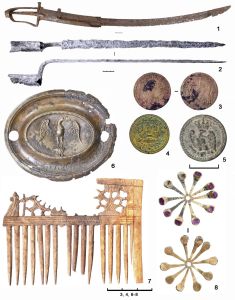 Nikolay A. Makarov*, Vladimir Yu. Koval**, Roman N. Modin***, Konstantin I. Panchenko****, Andrey V. Yaganov*****
Nikolay A. Makarov*, Vladimir Yu. Koval**, Roman N. Modin***, Konstantin I. Panchenko****, Andrey V. Yaganov*****
Институт археологии РАН, Москва, Россия
*E-mail: nmakarov10@yandex.ru
**E-mail: kovaloka@mail.ru
***E-mail: modin.roman@mail.ru
****E-mail: pakoi@mail.ru
*****E-mail: yagav@yandex.ru
Keywords: archaeology, architectural remains, the layout of the Kremlin, Moscow state, stratigraphy.
In 2019, the Institute of Archaeology RAS launched excavations in the area east of the Archangel Cathedral in the very centre of the Kremlin, where in the 16th–17th centuries Prikazy (central government departments of the Russian state) were located. For the first time, data were obtained on the nature and stratigraphy of cultural deposits of the 16th–19th centuries in the central part of the Kremlin and their relation to the historical events of that period. The works uncovered and cleared remains of a monumental stone structure which can be reliably correlated with the building of New Prikazy erected in 1675–1683. The was possible to distinguish horizons of the 1770s formed during the dismantling of the building of New Prikazy by V.I. Bazhenov and the strata of the middle – third quarter of the 17th century associated with the activities of Old Prikazy. Excavations yielded vivid material to characterize the situation of administrative workflow and everyday life of the central government of the 17th– the first half of the 18th century. An unexpected find of an assemblage of weapon and military equipment of the early 19th century on the Kremlin wasteland is a unique archaeological evidence of the Napoleonic army presence in the Kremlin. It is valuable for characterizing the general condition of Moscow after the fire and destruction of 1812.
DOI: 10.31857/S086960630010947-0







